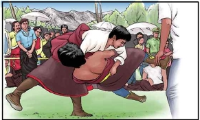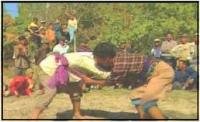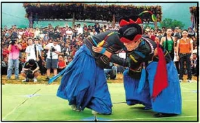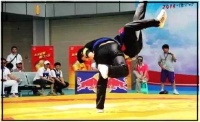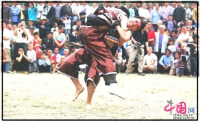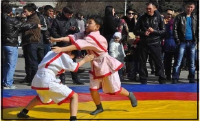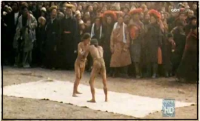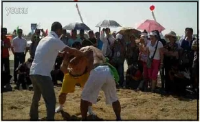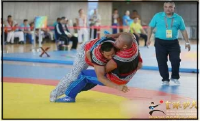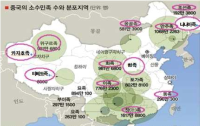PURPOSE This study aimed to explore ways to utilize augmented reality (AR) in school sports and leisure by examining the case of an elementary school sports club using augmented reality-based e-sports. METHODS A self-study approach and Eisner's(1995) educational criticism were utilized. Data including photos, videos, literature, and memory boxes related to the elementary school AR sports club were collected weekly during the school semesters from March 2023 to January 2024, spanning a total of 30 weeks. The data were analyzed following the stages of analysis by Elo & Kyngäs(2007). RESULTS Augmented reality can act as a personalized exercise coach by visualizing physical activity information. Through posture and movement analysis, education on physical strength and expression can be provided that is linked to home; it can also expand the range of sports experiences and create a new sports culture. In order to effectively utilize AR, edtech field experts must be trained, and content must be developed through cooperation between companies and schools. The educational effectiveness of the content must be verified and the management system must be inspected, and public facilities utilizing edtech must be expanded. CONCLUSIONS AR has endless development potential in school sports and leisure, but these will require active interest and support from educational authorities.
PURPOSE The purpose of this study was to investigate the risk factors for anterior cruciate ligament injury using the Landing Error Scoring System (LESS) and muscle activity during the drop vertical jump for overweight females. METHODS The body mass index was 18.5-22.9 kg/㎡ for normal weight females and 23-24.9 kg/㎡ for overweight females among 10 participants aged 20-30 years classified into groups of participants without any injury history and those who were right-footed. An automatic heigh-tweight machine, body composition analyzer, diagnostic imaging, electromyography with the LESS, and muscle activity analysis were used for measurements. The difference in muscle activity between the normal weight and overweight females was evaluated by independent t-test. RESULTS Overweight females had a smaller angle of knee bending during the drop vertical landing, leading to a smaller knee curve angle. In addition, they landed with an unbalanced foot touch on the ground inclined backward, thereby breaking the whole body balance. Overweight females had an incorrect posture compared with normal weight females, with higher LESS points. The muscle activity of the rectus femoris was higher than that of the biceps femoris, indicating a higher load on the muscle. CONCLUSIONS Overweight females take more load on the knee joint and cannot absorb the impact force properly. These results suggest a higher risk of anterior cruciate ligament injury in overweight females.
PURPOSE The purpose of this study is to analyze the type of and interest in home training video contents using the YouTube platform. METHODS Web crawling was performed using Python and a total of 3,937 sets ofvideo information (title, content, number of views, upload date) were obtained, 3,155 of which were finally selected for the study material. Overlapping and unrelated content were excluded. The data of text underwent 3 stages of preprocessing, the TF and TF-IDF of the keywords were calculated to identify the main keywords, and the LDA algorithm was applied in the topic modeling to successfully identify the types. In order to understand the level of interest by type, the number of views was subdivided into the percentage of the assigned type. RESULTS First, the types of home training videos were classified into bare whole body exercise for aerobic and muscular power strengthening, Pilates exercise for core and upper body strengthening, upper body exercise using tools, lower body line exercise, posture correction and upper body stretching exercise for pain relief, hip-up exercise, dance and tabata exercise for diet, diet and lower body correction stretching exercise for diet, and bare body exercise for core and lower body strengthening. Second, it was found that the proportion and interest were high in the contents of bare whole body exercise for aerobic and muscular power strengthening, dance and tabata exercise for diet, diet and lower body correction stretching exercise for diet. CONCLUSIONS The findings of this study may provide baseline data about the development of the active online home training videos in the market.
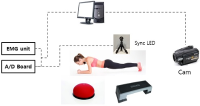
Purpose This study was to analyze and compare series of muscle activities during plank exercises with use of togu-jumper. Methods Ten male subjects (age 26.9±1.7 yrs, height 172.2±5.7 cm, weight 66.5±7.5 kg) who have no musculoskeletal disorder with one's upper or lower limb were selected as subjects. To analyze and compare series of muscle activity, five of surface EMG electrodes were attached to the upper rectus abdominis (URA), lower rectus abdominis (LRA), external abdominal oblique (EO), erector spinae (ES) and gluteus maximus (GM). Each subject did plank exercise on stable support surfaces (normal surfaces) and unstable support surfaces with the togu-jumper. For each dependent variable, one-way ANOVA with repeated measures were performed with significance level p<.05. Contrasts were performed to execute post tests for results with statistical significance. Results The study showed that the average IEMG values of URA and LRA increased in Upper (Togu-jumper used upper limb) compared to normal surfaces. This is perhaps because the effects of URA more than any other muscles for body stability. Furthermore, the peak IEMG values of LRA increased in Upper and Lower (Togu-jumper used lower limb) compared to normal surfaces. In addition, peak IEMG values of EO increased in Upper compared to Normal. This may have resulted due to momentary strong muscle activity in LRA and EO to correct body posture and balance. Therefore, using Togu-jumper on upper limb maximizes the performance of core training in plank exercise. Conclusions The study may be further applied to a method for effective training. It is considered that research and analysis has to be further done on modified plank exercise. Additionally, it is necessary to analyze not only global muscle but also local muscle, as a comprehensive research, to suggest ideal method for plank exercise.

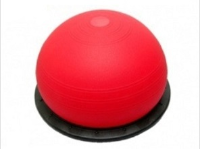
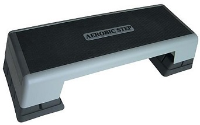
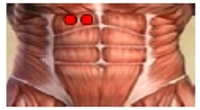
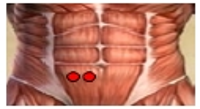

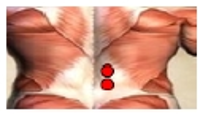
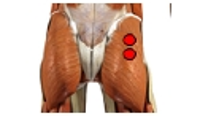

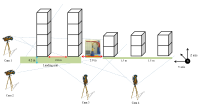
Purpose The purpose of the study was to perform a comparative analysis of the YANG Hak Seon technique carried out by "K" athlete with the kinematical data of "Y" athlete and propose a method to improve the YANG Hak Seon technique of "K" athlete. Method The subject recruited for the study was a male athlete from Korean national team (Age: 21, height: 1.65 m, body weight: 59.6 kg, and career: 11 years). Four high - speed cameras were used to analyze the 3D motion of the YANG Hak Seon technique performed by "K" athlete. The variables selected for analysis were the velocity of COM, displacement of COM, the rotational & torsional angle of the trunk and rotational & torsional angular velocity of the trunk. The results obtained were compared to the preexisting data of the "Y" athlete (data set from the published research). Results Firstly, the horizontal displacement of the YANG Hak Seon technique of the "K" athlete was observed to be shorter along with lower vertical displacement during landing compared to “Y” athlete. In addition, the overall horizontal velocity was low and vertical velocity was not generated which rises during the BC (board contact) phase. Although the rotational angular velocity of the trunk was lower during the BC, HC (horse contact) phase and LD (landing) phase, torsional angular velocity was higher during the LD. Conclusion In order to improve the completeness of the YANG Hak Seon technique of the K player, it is necessary to enter with a fast and low posture on the footplate during the initial phase. In the BC phase, it is essential to raise the COM simultaneously while landing on the footplate and increase the rotational angular velocity of the trunk.

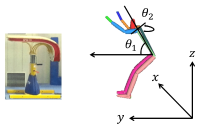
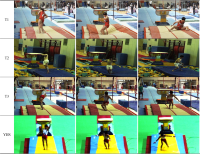
Purpose : The purpose of this study was to investigate coaching information with which coaches provided players during badminton competition. Methods : To this end, we generated an open-ended questions and presented it to 88 high school athletes registered in the Badminton Korea Association. The survey was conducted during a tournament and immediately after the tournament to collect the data. The collected data were categorized through inductive content analysis. Results : As a result of this study, a total of 480 raw data points collected through the open-ended survey were categorized into four general areas: psychological information, technical information, tactical information, and game operation information. Specifically, psychological information was divided into six subdivisions: concentration, confidence, relaxation/stabilization, mental toughness, play thought, and passion; technical information was broken into four subdivisions: strokes, footwork, swing and posture, and position preparation; tactical information had four subdivisions: coping to opponents, play changes, rotation, and manipulation of opponents; and, game operation information was divided into two subdivisions: taking the lead in a game and changing atmosphere. Conclusions : In other words, in badminton competition, the coaches strengthened psychological skills that promote psychological stability to attain the athletes’ peak performance and modified the athletes’ motion into the action necessary for achieving accurate techniques. Furthermore, they provided a variety of coaching information so that the athletes will respond appropriately to their opponents’ play, take the lead in games and induce a positive mood. The psychological, technical, tactical and game operation information offered by badminton coaches are the main factors influencing the performance of badminton players and suggest a need for the proper management and control of the coaches as well as athletes for the peak performance.
PURPOSE This study investigated weight-class-related strength parameters during pulling performance in the ssireum. METHODS Elite ssireum athletes participated, 24 divided into four weight classes of six athletes each. They performed a pulling task while gripping a tube fixed to a three-axes load cell sensor, standing on force plate platforms. The test involved 30 repetitions at maximal force with the legs bent, the ssireum’s typical posture. Maximal force (Fmax), time to maximal force (TFmax), time difference between maximal forces (TDmax), and horizontal and vertical angles at maximal force (HAmax and VAmax, respectively) were analyzed from the load cell sensors. Ground reaction force (GRF) was collected, including peak force along the three axes, the resultant force, and the center of pressure (COP). One-way ANOVA tests were conducted to compare among weight classes (α=.05). RESULTS Fmax measured by load cell showed significant difference between classes (p<.05), indicating that the second weight group (Geumgang class) generated more pulling force than the heavier classes. In GRF results, lightweight classes demonstrated larger COP difference between the left and right plates. Specifically, the Geumgang class showed more movement in the anterior-posterior (AP) direction on the left plate. The peak GRF in the right plate of the AP (p<.001) and ML (p<.05) directions showed significant differences between lighter and heavier weight classes. CONCLUSIONS The Geumgang class generated greater pulling force, and the lighter classes demonstrated more leg contribution. Force generation did not solely depend on body mass; instead, lighter athletes often relied on the lower limbs to compensate for their limitations, a strategy commonly observed in competitions.
PURPOSE This study aimed to analyze the dynamic posture stabilization and kinematic variables between visual feedback and Y-balance training groups during jump-landing. METHODS Thirty-eight male players (age: 22.6 ± 1.12 years, height: 175 ± 3.54 cm, weight: 65.5 ± 5.11 kg) were included in this study, and chronic ankle instability was checked using Cumberland Ankle Instability Tool (CAIT) and Balance Error Scoring System (BESS). They were randomly assigned to the Visual biofeedback (Training group: TG, n = 19) and Y-balance groups (Control group: CG, n = 19) for four weeks. TG performed balance training using the Biodex balance system (BBS) and CG performed training using the Y-balance system. During jump landing, time to stabilization (TTS), force plate (COP, GRF); joint angle and moment were collected and analyzed. All analyses were performed with SPSS 21.0, and Bonferroni was used for repeated measured ANOVA and post-hoc. RESULTS The results indicated that there was an interaction between TG and CG in terms of AP and ML directions of TTS (p < 0.05). AP/ML TTS of the TG for the post-test was smaller than that for CG (AP: p = 0.000; ML: p = 0.046). ML TTS of the TG for post-test was smaller than at pre-test (p = 0.041), and AP TTS of the CG for ankle joint moment (p < 0.05). There was an interaction between TG and CG in terms of dorsiflexion (DF) and plantarflexion (PF) of joint moment (p < 0.05). Ankle moment of the CG for post-test decreased than at pre-test (DF: p = 0.040, PF: p = 0.032), and ankle dorsiflexion moment of the CG for post-test was decreased than at pre-test (p = 0.046). CONCLUSIONS Balance ability was achieved more effectively through visual biofeedback training than Y-balance training. Therefore, we recommend balanced training with visual feedback on chronic ankle instability.
PURPOSE The purpose of this study was to investigate whether foam roller, preexhaustion, and static stretching had any effect on isometric muscular endurance of the finger flexors and climbing performance in sport climbers. METHODS Nine sport climbers who were able to perform at a climbing difficulty of 5.11d, were included in this study. Warm-up exercise consisted of myofascial release, pre-exhaustion exercises, and static stretching. Grip and back strengths were measured for muscular strength, and isometric muscular endurance of the finger flexors was measured as the time spent hanging on each hold according to the angle of the elbow joint. Repeated measures of ANOVA were performed to confirm the difference in treatment, and a significant difference between groups was confirmed by contrast test. RESULTS Myofascial release, pre-exhaustion, and static stretching before climbing did not affect muscle strength. However, the static stretching exercise significantly decreased isometric muscle endurance of the finger flexor at 90° open hold, and the pre-exhaustion exercise significantly decreased the hanging time at 180° crimp and slope grips. There was no effect on climbing performance according to the type of warm-up exercise. CONCLUSIONS Our findings suggested that various warm-up exercises did not directly affect muscle strength, muscular endurance, and climbing performance in sport climbers. Thus, we suggest that future research on complex warm-up exercises considering climbing postures should be conducted.
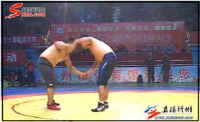
This research begins from the awareness that even though there are different forms of wrestlings in the ethnic minority groups in China, the study on their morphological aspects has reached the limit. Based on the documents and VOD data about these wrestlings of each ethnic group, their morphological characteristics can be verified as follows. First, The postures of Han and Mongolian people take the way of two players standing and playing, and Korean-Chinese people and Hui people take a saddle stance using a thigh band. Second, as for the arenas for the wrestlings, owing to some geographical features and natural environments, they were set up at a specific area during the traditional era using natural objects(grass, lawn, soil, sand). Yet, in the modern times, they have been changed as being installed and run in modernized gyms, sports fields, or parts following the standard of stadium facilities supervised by each organization. Third, with regard to the play wear of wrestling, some parts of the traditional costumes have been transmitted and worn. However, in case of most of the traditional costumes, it has been found out that modernized clothes which take the forms of garments developed since the modern era into consideration are being used. Fourth, in terms of the game equipments of wrestling, certain clothes(uniform, vest), running shoes and a band(a thigh band) should be worn.


